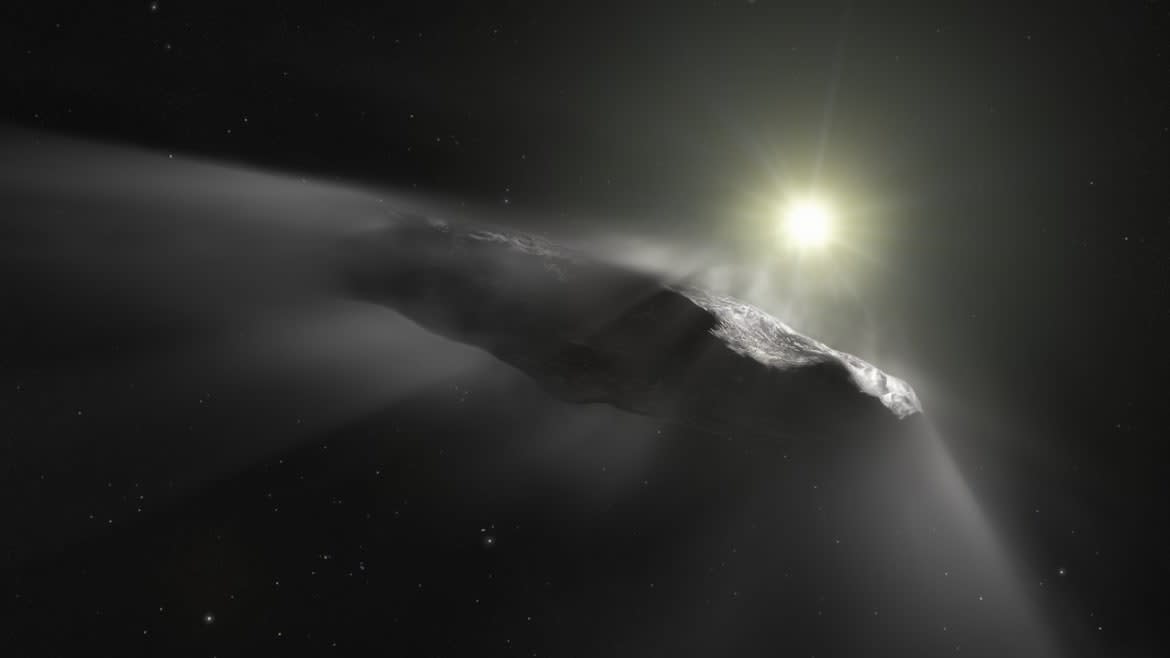Why This Bizarre Space Rock (Probably) Wasn’t Made by Aliens

If you’ve read The Daily Beast within the last few years, then you probably know this story already: in 2017, a weird rock from interstellar space decided to make a little visit to our little solar system here. Just a quick little flyby. The object, named ‘Oumuamua and thought to be a comet, was quite strange for a number of reasons. For one, it had an elongated rod shape and lacked a tail of gas and dust that’s typical for a comet that’s spewing off frozen bits of matter. Perhaps most strangely of all, it was accelerating as it moved through the solar system.
For most scientists, ‘Oumuamua represented an anomalous figure we’d need to spend years studying in order to explain how it might have exhibited these very strange characteristics. For others, however, these were signs that we had just been visited by an object made by intelligent extraterrestrials. And in the ensuing years, that speculation hasn’t waned—in fact it’s only fueled notions that even more alien ships of similar design have visited our neck of the universe.
But here comes the cold water: a new study published in Nature on Wednesday has concluded that ‘Oumuamua’s odd acceleration was probably not because of some kind of extraterrestrial technology, but rather due to gas. The model suggests that hydrogen released from ice reserves simply led to an outgassing that pushed the object forward and caused it to speed up. Its physics are a bit unusual for a comet—but not out of the realm of what’s possible.
Why One Harvard Astronomer Believes This Asteroid Is an Alien Ship
“Our model can reconcile the non-gravitational acceleration of ‘Oumuamua with the non-detection of typical comet activity tracers, requires no fine tuning, and is grounded in our understanding of solar system objects and the experimentally determined behavior of amorphous ices,” study co-author Jennifer Bergner, who studies comet chemical reactions at the University of California, Berkeley, told The Daily Beast in an email. “Our model is consistent with Oumuamua being broadly similar to icy planetesimals like solar system comets.”
Comets are big rocks made of dirty, dust-covered ice. When they get closer to the sun, that ice is superheated, and the comet starts to eject water, dust, and other molecules, giving comets their very notable comas (the bright halos we see in pictures).
‘Oumuamua baffled scientists because it didn’t have a coma or a tail, and its trajectory was too far from the sun for it to eject water. Some experts began to speculate that gasses were at play, including hydrogen. Darryl Seligman, a colleague of Bergner’s who is now at Cornell University and a co-author of the new paper, even once speculated that perhaps the object was made entirely of hydrogen.
‘Alien Spy Ship’ Space Object May Be Chunk of Pluto-Like Planet
Bergner and Seligman decided to figure out if they could develop a model for how hydrogen could explain how the object accelerated through space. Because ‘Oumuamua was such a small size, outgassing from a thin hydrogen coma might actually produce enough force to cause acceleration.
The model they came up with fits the bill. Hydrogen trapped in ice on ‘Oumuamua could be exposed to the heat of the sun in such a way that the structure of the ice changes and forces bubbles out, releasing hydrogen gas into space with enough force to accelerate the object forward.
‘Oumuamua: ‘Big Dumb Rock’ or Alien Spy Ship? Scientists Spar Over Mystery Interstellar Object
The model also helps explain why ‘Oumuamua doesn’t have a coma made of dust, since the heated ice isn’t melting or sublimating, but simply rearranging its structure to allow outgassing. The model also fits into a broader explanation for the behavior of other “dark comets” that lack a bright coma.
“It’s unlikely that we can definitively confirm the nature of ‘Oumuamua’s non-gravitational acceleration, because we have so little information about it,” said Bergner. “But, our model is generic, and therefore this mechanism is testable if we discover small comets originating in the outer solar system in the future.”
Pour one out for all the alien enthusiasts out there.
Get the Daily Beast's biggest scoops and scandals delivered right to your inbox. Sign up now.
Stay informed and gain unlimited access to the Daily Beast's unmatched reporting. Subscribe now.


